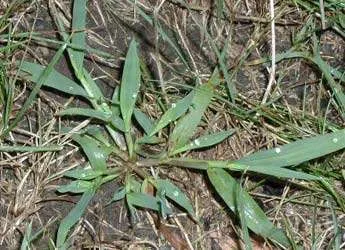K-State horticulture expert explains best practices for treating crabgrass
MANHATTAN, Kan. – A weed commonly found in Kansas lawns can sure make homeowners feel pretty crabby this time of year.
But applying an herbicide at the right time can help alleviate crabgrass problems, said Kansas State University horticulture expert Ward Upham.
“For most of Kansas, crabgrass typically begins to germinate around May 1 or a little later,” Upham said. “April 15 is normally a good target date for applying crabgrass preventer because it gives active ingredients time to evenly disperse in the soil before germination starts.”
Crabgrass preventers are another name for pre-emergence herbicides that prevent crabgrass seeds from developing into mature plants. “They do not kill the weed seed or even keep the seed from germinating, but rather kill the young plant after it germinates,” Upham said.
He added that crabgrass preventers have no effect on existing plants, “so they must be applied before germination.”
“Preventers do not last forever once applied to the soil. Microorganisms and natural processes begin to gradually break them down soon after they are applied. If some products are applied too early, they may have lost much of their strength by the time they are needed.”
Upham said most crabgrass preventers are fairly ineffective after 60 days. Two products – Dimension and Barricade — provide season long control of crabgrass from a single application, and can be applied earlier than April 15. Barricade can be applied as early as March 1.
If not using one those two products, however, the proper time to apply a crabgrass preventer falls usually is the same time that the Eastern Redbud tree – known for its pretty pink flowers — is in full bloom.
“We recommend that homeowners apply crabgrass preventers before fertilizer so that the grass isn’t encouraged to put on too much growth too early,” Upham said. “However, it may be difficult to find products that contain pre-emergents without fertilizer.”
Upham provides a short list of crabgrass preventers that do not contain fertilizer in this week’s Horticulture Newsletter, a weekly publication produced by he and his colleagues in K-State’s Department of Horticulture and Natural Resources.
In addition to the weekly newsletter, interested persons can send their garden- and yard-related questions to Upham at wupham@ksu.edu, or contact your local K-State Research and Extension office.
FOR PRINT PUBLICATIONS: Links used in this story
K-State Horticulture Newsletter, https://hnr.k-state.edu/extension/info-center/newsletters/index.html
K-State Research and Extension local offices, www.ksre.k-state.edu/about/stateandareamaps.html
K State Research and Extension is a short name for the Kansas State University Agricultural Experiment Station and Cooperative Extension Service, a program designed to generate and distribute useful knowledge for the well being of Kansans. Supported by county, state, federal and private funds, the program has county extension offices, experiment fields, area extension offices and regional research centers statewide. Its headquarters is on the K State campus in Manhattan. For more information, visit www.ksre.ksu.edu. K-State Research and Extension is an equal opportunity provider and employer.
Story by:
Pat Melgares
785-532-1160
melgares@ksu.edu
For more information:
Ward Upham
785-532-6173
wupham@ksu.edu





